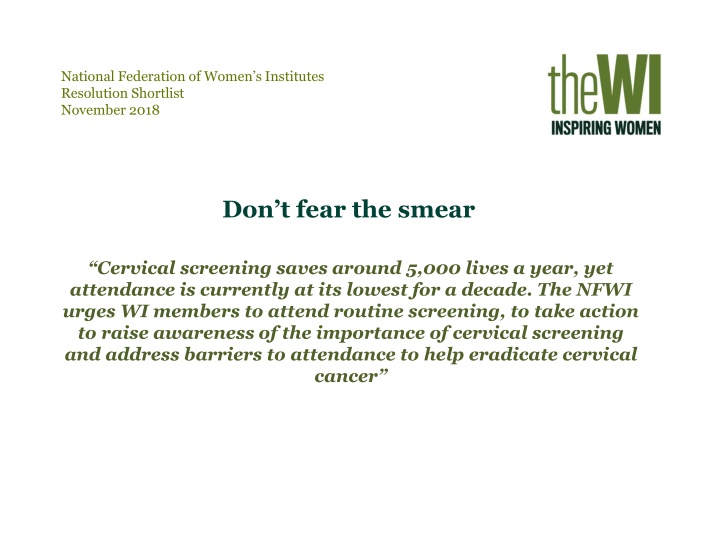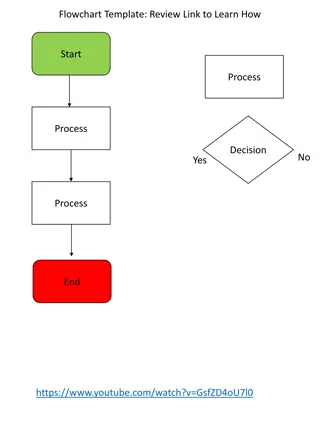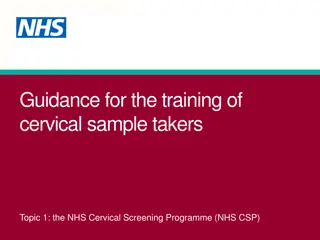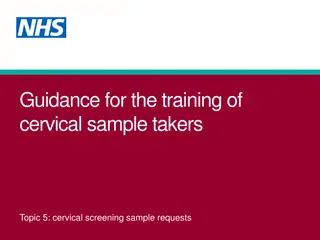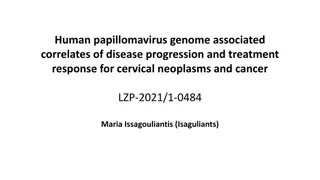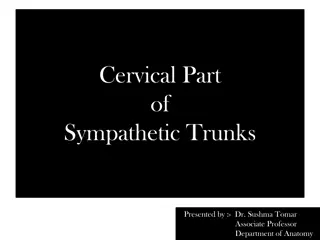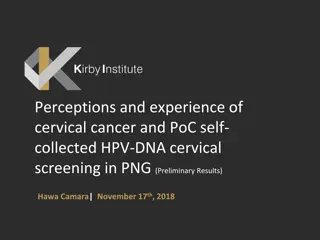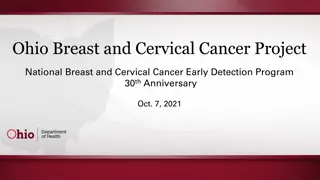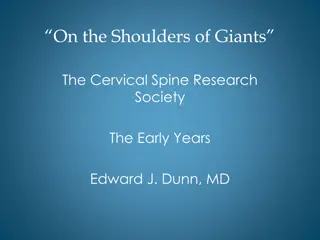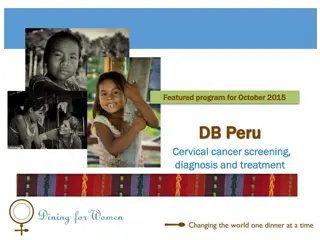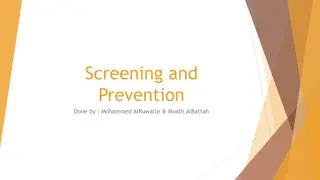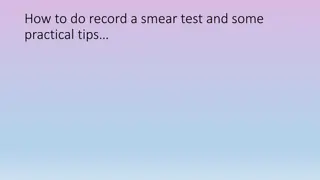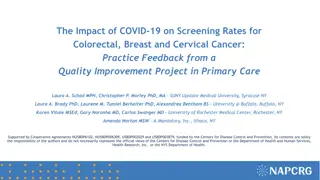Don't Fear the Smear: Cervical Screening Awareness
Cervical cancer screening is vital in saving lives, yet attendance is at a decade low. This resolution urges action to raise awareness, address barriers, and eradicate cervical cancer. Explore the current situation in the UK, the scale of the problem, and how the WI can work towards this cause, emphasizing the importance of routine screening and highlighting ways to improve attendance rates. Take a closer look at the impact, challenges, and potential solutions surrounding cervical screening to make a difference in women's health.
Download Presentation

Please find below an Image/Link to download the presentation.
The content on the website is provided AS IS for your information and personal use only. It may not be sold, licensed, or shared on other websites without obtaining consent from the author.If you encounter any issues during the download, it is possible that the publisher has removed the file from their server.
You are allowed to download the files provided on this website for personal or commercial use, subject to the condition that they are used lawfully. All files are the property of their respective owners.
The content on the website is provided AS IS for your information and personal use only. It may not be sold, licensed, or shared on other websites without obtaining consent from the author.
E N D
Presentation Transcript
National Federation of Womens Institutes Resolution Shortlist November 2018 Don t fear the smear Cervical screening saves around 5,000 lives a year, yet attendance is currently at its lowest for a decade. The NFWI urges WI members to attend routine screening, to take action to raise awareness of the importance of cervical screening and address barriers to attendance to help eradicate cervical cancer
Outline of presentation What is the scale of the problem? The current situation in the UK How the WI could work on this issue if it was passed Arguments for the resolution Arguments against the resolution Further information
What is the scale of the problem? It is estimated that the smear test currently prevents 70% of cervical cancer deaths. However, this figure could be 83% if all eligible women attended. 72% of eligible women in England had been screened within the specified time frame as of March 2017. This is a decrease from 75.7% in 2011. Attendance is lowest amongst women aged 25 to 29 (62.1%), yet cervical cancer is the most common cancer among women under the age of 35. In Wales, the number of women attending has also fallen slightly in recent years. As of March 2017, 77% of eligible women had been screened at least once within the last 5 years, a drop from 77.8% in 2015/16.
The current situation in the UK In England and Wales, women aged 25 to 49 who are registered with a GP are invited for cervical screening (also referred to as a smear test ) every 3 years. Women aged 50-64 receive invitations every 5 years. Public Health England cites several barriers to attendance. There is evidence to suggest that a better understanding of what the test is for and why it is important would encourage more women to attend. Public Health England plans to launch a high profile campaign in early 2019.
The current situation in the UK continued The voluntary sector can play a part in making cervical screening more accessible. Clinical Commissioning Groups (CCGs), local authorities and primary care teams also have an important role. Yet, data obtained by the charity Jo s Cervical Cancer Trust found that 60% of CCGs and 44% of local authorities had not undertaken any activities to address the problem of screening attendance rates. Girls between 12-18 years old are offered the Human Papilloma Virus (HPV) vaccine. This helps to protect against four types of HPV, two of which cause 70% of cervical cancers in the UK. Cervical screening can also help identify small cell cervical cancer, which the HPV vaccine does not fully protect against.
How the WI could work on this resolution At local and regional levels-members could help tackle some of the barriers preventing many women attending cervical screening by raising awareness of the screening programme and the benefits of attending. Members could also encourage primary care to run awareness campaigns and call on CCGs and local authorities in England and local trusts in Wales to take action to improve attendance rates. Nationally-the NFWI could build the evidence base around why some women do not attend cervical screening to help inform regional and local initiatives to tackle the problem. Alongside expert organisations, the NFWI could also push for improvements in care that are known to increase cervical screening uptake.
Arguments for the resolution Cervical cancer screening has been a longstanding concern of the WI. A WI resolution was passed in 1964 calling on the NHS to provide comprehensive and routine smear tests for all women in order to detect cervical cancer. This resolution would enable members to build on the WI s earlier work to introduce routine smear tests by helping to increase public understanding of and engagement with the screening programme. This resolution is timely.
Arguments against the resolution There is an existing annual awareness raising campaign that highlights the importance of cervical screening and encourages more women to attend. Is there more the WI could add?
Further information NFWI Public Affairs Department E: pa@nfwi.org.uk T: 020 7371 9300 https://www.thewi.org.uk/campaigns NHS Digital: https://files.digital.nhs.uk/pdf/t/b/cervical_bulletin_report_2016-17_-_final.pdf Government: https://www.gov.uk/government/news/call-for-women-to-get- life-saving-smear-test-after-uptake-drops# Jo s Trust: https://www.jostrust.org.uk/node/1073042 Video: This video by Jo s Trust explains the smear test: https://www.jostrust.org.uk/video/you-guide-cervical-screening-smear-test
